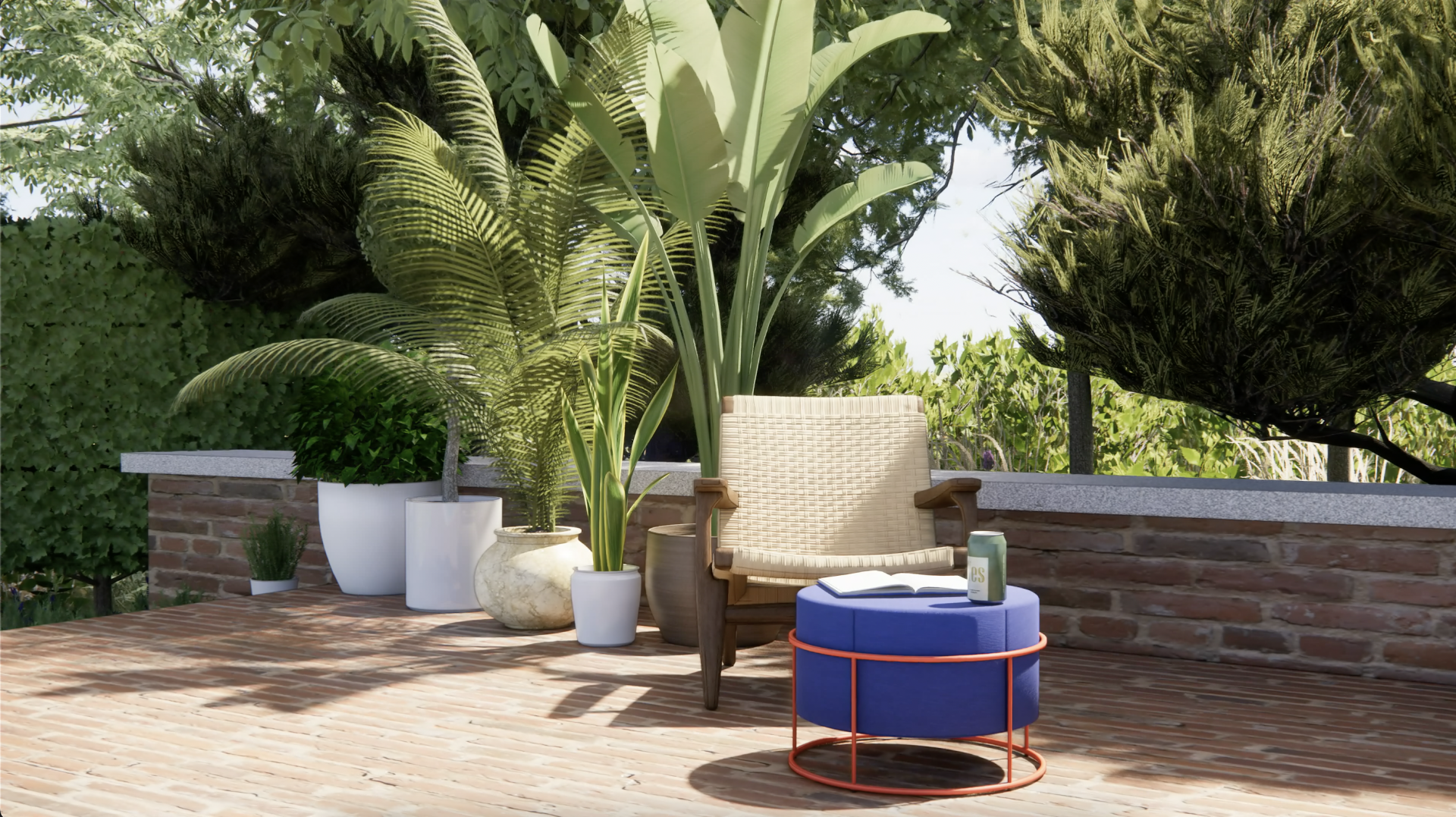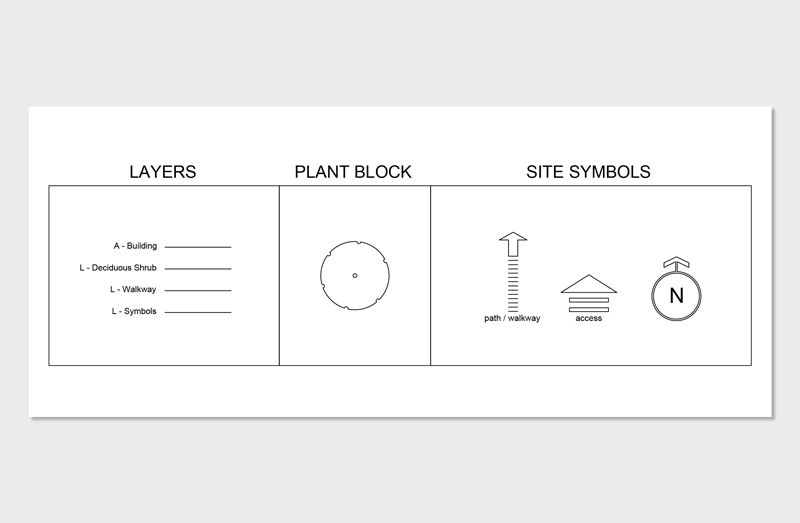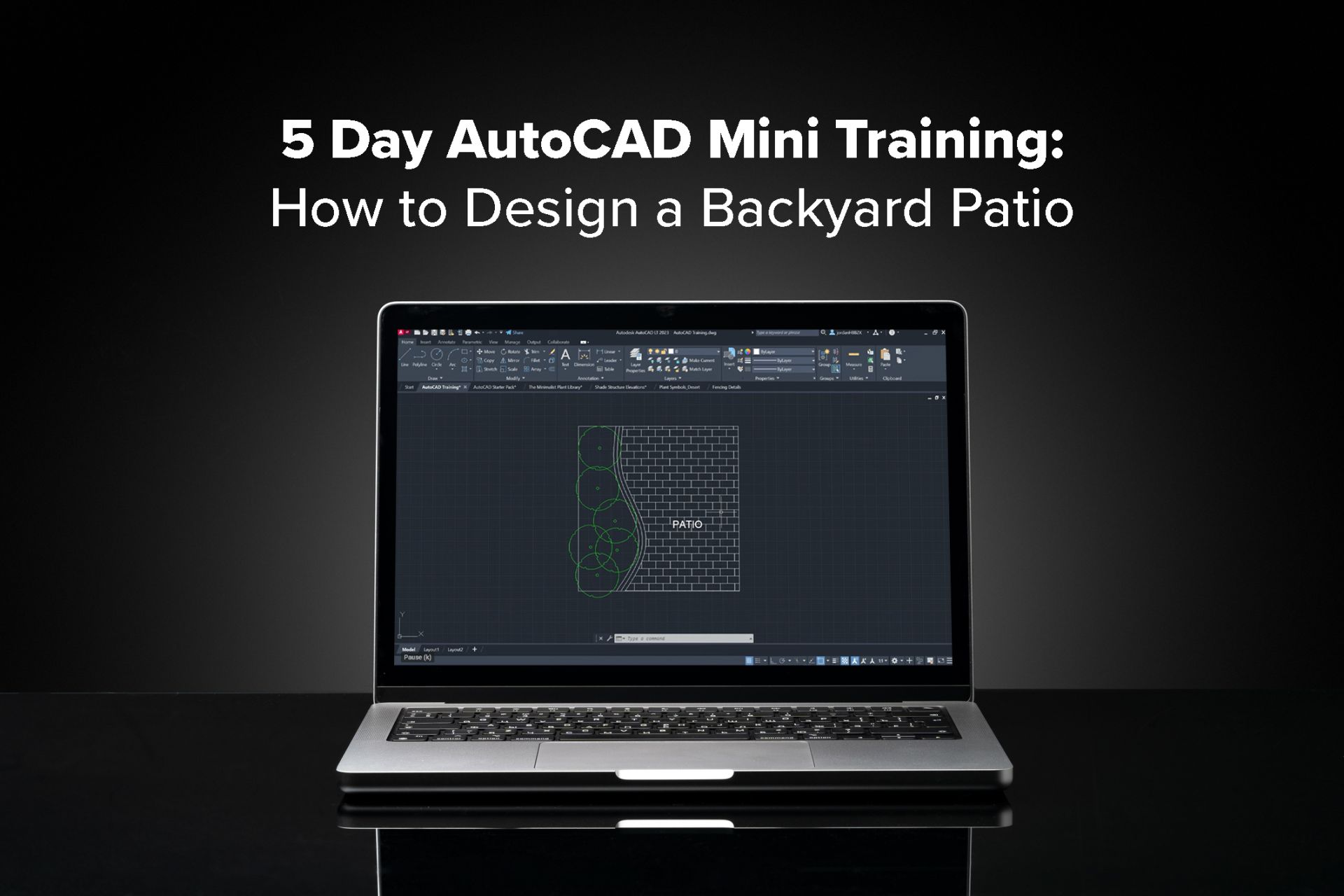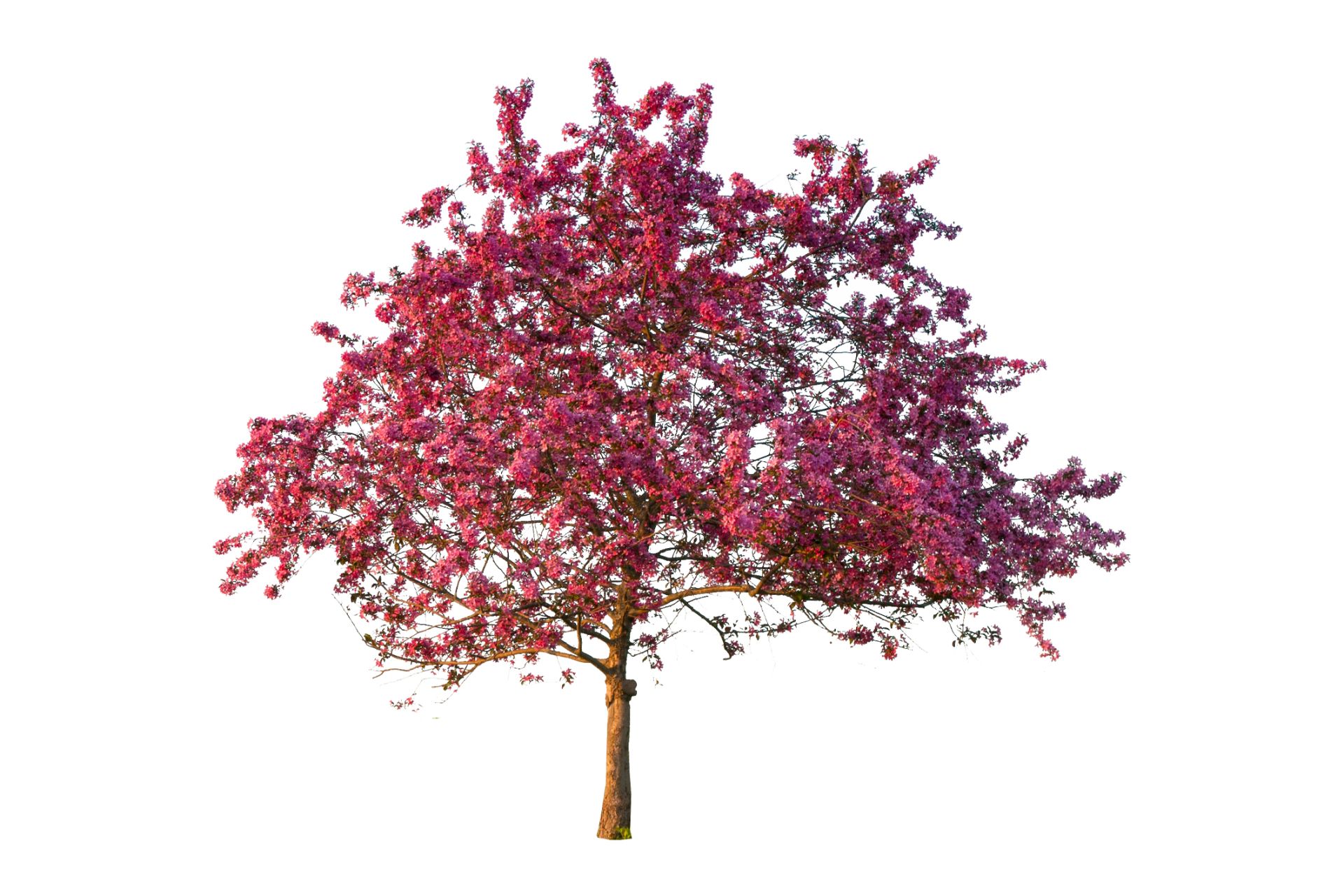Aug 30 • Jordan Felber
Landscape Design Rendering: Techniques, Tools, and Best Practices
Related — Rhino 3D Training for Landscape Designers

Landscape design rendering software is one of the most powerful tools for communicating ideas in landscape architecture.
A well-crafted 2D and 3D landscape rendering transforms site plans and models into immersive visuals that help clients clearly understand a design before construction begins.
These professional landscape renderings don’t just impress — they build trust, streamline approvals, and minimize costly revisions.
With advances in real-time landscape rendering technology, professionals now have more options than ever to create compelling images and walkthroughs.
This article will explore techniques, tools, and best practices for landscape design rendering, and show how mastering this skill can elevate both your workflow and your client presentations.
A well-crafted 2D and 3D landscape rendering transforms site plans and models into immersive visuals that help clients clearly understand a design before construction begins.
These professional landscape renderings don’t just impress — they build trust, streamline approvals, and minimize costly revisions.
With advances in real-time landscape rendering technology, professionals now have more options than ever to create compelling images and walkthroughs.
This article will explore techniques, tools, and best practices for landscape design rendering, and show how mastering this skill can elevate both your workflow and your client presentations.
What Is Landscape Design Rendering?
At its core, landscape design rendering for professionals is about communication. It takes the raw information of a site plan or 3D model and turns it into realistic landscape renderings that are easy for clients and stakeholders to understand. These visuals can range from 2D landscape design renderings that convey layout and intent, to 3D photorealistic landscape renderings that replicate real-world conditions. Each type of rendering serves a unique purpose depending on the stage of the design process.
Renderings play a critical role in bridging the gap between design and execution. In the concept phase, conceptual landscape renderings help test ideas and spark conversation. During schematic design, digital landscape renderings demonstrate scale, planting strategies, and circulation patterns. By the time a project reaches presentation, photorealistic landscape design renderings give clients confidence in the design and help secure approvals with fewer revisions.
Ultimately, landscape design rendering matters because it eliminates misinterpretation. Clients may struggle to understand a technical drawing, but a rendering lets them instantly connect with the vision. It’s a way to build trust, reduce costly back-and-forth, and ensure everyone involved shares the same understanding of the final outcome.
Renderings play a critical role in bridging the gap between design and execution. In the concept phase, conceptual landscape renderings help test ideas and spark conversation. During schematic design, digital landscape renderings demonstrate scale, planting strategies, and circulation patterns. By the time a project reaches presentation, photorealistic landscape design renderings give clients confidence in the design and help secure approvals with fewer revisions.
Ultimately, landscape design rendering matters because it eliminates misinterpretation. Clients may struggle to understand a technical drawing, but a rendering lets them instantly connect with the vision. It’s a way to build trust, reduce costly back-and-forth, and ensure everyone involved shares the same understanding of the final outcome.
Learn how to create photo-realistic landscape renderings.
>> Enroll in Online Course
>> Enroll in Online Course
Key Techniques in Landscape Design Rendering
Landscape rendering techniques are not one-size-fits-all. The right approach depends on the goals of the project, the stage of design, and the audience you’re presenting to. From hand-drawn landscape renderings to cinematic 3D landscape flythroughs, each technique has its own strengths. Below are three core rendering methods every professional should understand and apply.
2D vs 3D Rendering Styles
2D landscape renderings remain a staple for early-stage design work, especially when conveying basic concepts. These can take the form of CAD elevations, hand-drawn sketches, or simple diagrammatic visuals. By contrast, 3D landscape renderings provide depth, proportion, and scale, helping clients visualize exactly how a design will feel in real-world conditions.
Photorealistic Renderings
As projects advance, photorealistic landscape renderings become increasingly important. Advanced rendering software allows designers to simulate natural lighting, apply realistic textures, and incorporate detailed 3D plant models for landscapes. With water features, paving, and shadows included, the results often look nearly identical to professional photography.
Animation and Walkthroughs
For maximum engagement, landscape animation renderings and virtual walkthroughs for landscape design offer an immersive way to experience a project. Flythrough videos or VR landscape renderings allow clients to virtually walk through a space before it’s built. This interactivity builds excitement, explains spatial relationships, and can even double as high-quality marketing material.
Essential Software for Landscape Design Rendering
The quality of your landscape design rendering software directly impacts the clarity and realism of your visuals. Today’s options range from landscape modeling software that provides technical precision, to real-time rendering tools for landscape design that deliver instant, photorealistic previews. To get the best results, professionals also need the right hardware setup to support complex files and rendering engines. Below is a breakdown of the essential software and systems every designer should consider.
3D Modeling Software
Base 3D modeling tools like Rhino, SketchUp, and Vectorworks Landmark form the foundation of a rendering workflow. These programs ensure accuracy in geometry, site dimensions, and construction layout. Keeping models clean and CAD layers organized is critical, because sloppy input leads to rendering inefficiencies and unnecessary troubleshooting.
Rendering Engines and Plugins
This is where designs come to life with realism and atmosphere.
- Lumion for landscape rendering is widely used thanks to its plant library, weather effects, and cinematic animations.
- Enscape offers real-time rendering for landscape architects, giving clients instant previews and reducing revision time.
- D5 Render is gaining attention with its real-time ray tracing rendering and simple interface
Hardware + System Requirements
High-quality landscape design renderings are demanding on hardware, and the right setup makes a significant difference. A powerful GPU for landscape rendering — especially NVIDIA RTX cards with ray tracing — ensures smoother performance and more realistic results. Sufficient RAM and VRAM for rendering software allow larger models and complex outdoor scenes to process without crashing. For professionals, investing in a workstation for 3D landscape rendering isn’t a luxury but a necessity for efficiency and reliability.
View our list of recommended hardware on Amazon.
View our list of recommended hardware on Amazon.
Real-Time Rendering Plugins
Real-time rendering plugins for landscape design, such as Enscape and D5, integrate directly into modeling programs. They give designers instant feedback by allowing them to adjust lighting, swap materials, or test planting palettes on the spot. This immediacy makes client presentations more dynamic and design revisions significantly faster.
Ray Tracing and Material Libraries
Ray tracing rendering for landscape design has set a new standard by accurately simulating how light and reflections behave. When paired with high-quality landscape material libraries and 3D plant libraries for rendering, designers can create visuals that feel highly authentic. Subtle details like stone texture, dappled light under trees, and shadow depth help clients emotionally connect to a design.
Post-Processing Tools
Even the best rendering software often benefits from a final polish. Programs like Photoshop and Lightroom remain staples for landscape rendering post-production, enhancing colors, atmosphere, and composition. Meanwhile, AI tools like Rendair for landscape rendering are emerging, automating repetitive refinements and enabling designers to focus more on creativity and storytelling.
Best Practices for Effective Landscape Design Rendering
Great landscape rendering results require more than just the right software — they depend on process, consistency, and attention to detail. Following proven best practices for landscape rendering ensures your visuals are both accurate and persuasive. From workflow efficiency to lighting choices and plant selections, these strategies help elevate professional presentations. By applying these methods, designers can consistently deliver high-quality landscape design renderings that inspire client confidence.
Workflow Efficiency
Strong workflow habits are the backbone of efficient landscape rendering workflows. Keeping CAD layers organized, maintaining consistent naming conventions, and cleaning models reduces errors and saves valuable time. Linking CAD files directly into landscape rendering software also ensures that design updates flow seamlessly without the need to recreate models from scratch.
Lighting and Atmosphere
Lighting techniques for landscape renderings can dramatically change how a design is perceived. Using golden hour lighting, seasonal adjustments, or simulated weather effects creates emotion and realism. Thoughtful atmosphere elevates a project from a flat technical image into an immersive 3D landscape rendering experience.
Plants and Materials
Landscapes feel authentic only when vegetation and materials are represented accurately. Using realistic plant models for 3D landscape design, scaling them appropriately, and randomizing placement prevents repetitive patterns. When combined with accurate landscape material libraries, these choices make renderings both visually convincing and professionally persuasive.
Why Rendering Matters for Professionals
In modern practice, landscape rendering for professionals has shifted from optional to essential. Clients increasingly expect clear and realistic landscape design renderings before committing to large investments. By delivering these visuals, designers reduce miscommunication, speed up approval timelines, and minimize costly revisions during construction. Strong rendering skills ensure projects move forward with clarity and client confidence.
Beyond communication, renderings provide firms with a competitive advantage. Producing high-quality landscape rendering services demonstrates expertise and professionalism, helping designers stand out in crowded markets. These visuals can be used not only for client presentations but also for marketing, proposals, and portfolios. For many firms, offering landscape rendering as a service has become a valuable way to generate new revenue streams while strengthening client relationships.
Beyond communication, renderings provide firms with a competitive advantage. Producing high-quality landscape rendering services demonstrates expertise and professionalism, helping designers stand out in crowded markets. These visuals can be used not only for client presentations but also for marketing, proposals, and portfolios. For many firms, offering landscape rendering as a service has become a valuable way to generate new revenue streams while strengthening client relationships.
Learn Landscape Design Rendering with Expert Guidance
While landscape rendering software is more powerful than ever, it can also feel overwhelming to navigate. Many professionals waste hours experimenting with different tools instead of focusing on design. Without a clear system, the process of creating professional landscape design renderings often becomes frustrating, inefficient, and inconsistent.
Learn How to Create High-Quality Realistic Landscape Renderings Here.
Our landscape rendering course for professionals was created to solve this problem. It walks you step-by-step through the rendering process, showing how to move from CAD drawings to photorealistic landscape renderings using industry-standard tools. By following a repeatable rendering workflow, you’ll save time, produce higher-quality results, and deliver presentations that truly impress clients. Explore this online course to learn landscape rendering and start building skills that will elevate your design practice and client communication.
Learn How to Create High-Quality Realistic Landscape Renderings Here.
Our landscape rendering course for professionals was created to solve this problem. It walks you step-by-step through the rendering process, showing how to move from CAD drawings to photorealistic landscape renderings using industry-standard tools. By following a repeatable rendering workflow, you’ll save time, produce higher-quality results, and deliver presentations that truly impress clients. Explore this online course to learn landscape rendering and start building skills that will elevate your design practice and client communication.
Learn how to use Rhino to build 3D landscape models and create photo-realistic landscape renderings with Enscape.
Learn About Online Course Here
Learn About Online Course Here
Frequently Asked Questions (FAQs) About Landscape Design Rendering
What do landscape designers use to create visual renderings?
Landscape designers use a combination of landscape design software and rendering tools to create visual renderings. Base modeling is often done in programs like AutoCAD, Rhino, SketchUp, or Vectorworks Landmark, which provide accurate site layouts and geometry. To bring those models to life, designers use rendering engines such as Lumion, Enscape, D5 Render, or V-Ray, which add photorealistic lighting, materials, and plant libraries.
What does rendered mean in landscape design?
In landscape design, “rendered” refers to the process of turning a technical drawing or 3D model into a visual image that communicates the design. A rendered landscape plan or 3D scene can range from a stylized diagram to a fully photorealistic image that looks like a photograph. Renderings help clients, contractors, and stakeholders clearly understand the intended design before construction begins.
What is ray tracing?
Ray tracing is a rendering technology that simulates the way light naturally behaves in the real world. In landscape design rendering, ray tracing produces highly realistic effects such as soft shadows, reflections on water, and light filtering through trees. By calculating how light rays interact with materials and surfaces, it creates visuals that look much closer to a real photograph, helping clients better understand the atmosphere of a proposed design.

The Landscape Library Academy is an online platform teaching landscape professionals, students, homeowners and enthusiasts how to design landscapes and master software for the field.
The Landscape Library Academy is the education division of The Landscape Library.
Click here to visit TheLandscapeLibrary.com for media including education articles, projects features and more.
The Landscape Library Academy is the education division of The Landscape Library.
Click here to visit TheLandscapeLibrary.com for media including education articles, projects features and more.
Copyright © 2025




